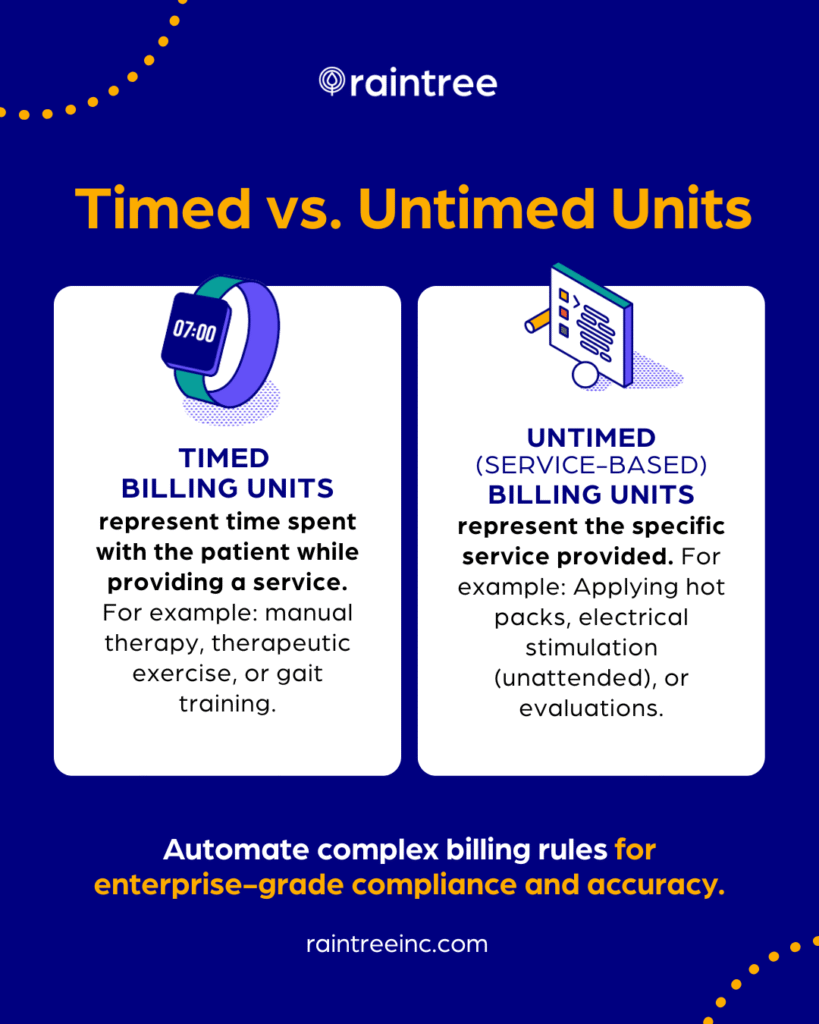In physical therapy, accurate billing isn’t just about getting paid. It’s also about documenting the value of the care delivered by your practice.
When all the rules and calculations start to feel like a financial obstacle course, understanding PT billing units is key. Each service you provide, whether guiding a patient through therapeutic exercises or conducting an evaluation, is quantified into billing units.
Let’s break it all down by looking at what physical therapy billing units are, how they work, and what you need to know to maximize reimbursements.
What are Billing Units in Physical Therapy?
Billing units in physical therapy are standardized units reflecting the time, skill, and resources invested during a therapy session. Based on factors such as time or complexity of the service, they serve as a common language between healthcare providers and payors, ensuring services are accurately documented, billed, and reimbursed.
Who Needs to Understand Physical Therapy Billing Unit Codes
Billing units aren’t just for billers—they’re essential for therapists, front office staff, and practice admins too.
Physical therapists. Accurate documentation and treatment plans rely on knowing the right billing units.
Front office staff. Understanding billing units allows you to answer patient inquiries confidently.
Administrators and compliance officers. Train staff, ensure compliance, and optimize billing processes, all with billing unit knowledge.
Types of PT Billing Units
Billing units break down to two main types, which affect the way you get paid:
Timed units calculate the time spent with the patient. Think manual therapy, therapeutic exercise, and gait training.
Untimed (service-based) billing units aren’t about time, but the specific service provided. Think hot packs, electrical stimulation (unattended), or evaluations.
Timed Billing Units for Physical Therapy Services
Timed billing units measure the duration of the therapy session. Each unit represents a specific time increment, typically 15 minutes. For example, a 45-minute session would be billed as three units. Timed billing provides a straightforward way to track and bill for therapy services based on the amount of direct, one-on-one contact the therapist has with the patient.
Common CPT codes for time-based units include:
Therapeutic exercise (97110). Guiding the patient through targeted movements.
Manual therapy (97140). Employing hands-on techniques for pain relief and mobility.
- Neuromuscular re-education (97112). Training the nervous system to improve function.
Gait training (97116). Functional training for improved walking and mobility.
Time is money here. As a general rule, every 15 minutes of direct interaction earns you one billing unit, with an additional unit billed for any remaining 8+ minutes per Medicare’s 8-minute rule, which we’ll discuss later.
Untimed (Service-Based) Billing Units for PT Services
Untimed or service-based billing units are billed for a single unit, regardless of how long the service takes to perform. Think of them as services requiring your expertise but not necessarily your constant presence.
Common CPT codes for service-based units include:
Evaluation (97161-97163). Assessing the patient’s condition and establishing a treatment plan.
Re-evaluation (97164). Tracking progress and adjusting the plan as needed.
Supervised modalities (97010-97028). Utilizing tools like heat, ice, or electrical stimulation under your supervision.
Tests and measurements (97750-97755). Assessing range of motion, strength, or other functional aspects.
Calculating Billing Units: Additional Considerations for Physical Therapy Practices
So, if you are providing direct, one-on-one care, you will use a time-based unit. If you are providing a service that doesn’t require your direct, one-on-one attention, you will use a service-based unit. After that, things get a little more interesting.
Here are some additional factors to consider when calculating units:
Physical Therapy Billing Modifiers
Modifiers in medical billing add context to your service codes, impacting how they’re billed. Modifiers like GP (services provided under an outpatient physical therapy plan of care) or KX (Medicare cap was met, but it’s deemed medically necessary to continue treatment) are essential for accurate billing.
The 8-Minute Rule
Medicare (and many other payors) follow the 8-minute rule for time-based billing. This means you can only bill for one unit of service for every 15 minutes of direct contact with the patient, with an additional unit allowed if 8 minutes or more remain.
Mixed Remainders
When calculating units for Medicare, mixed remainders can occur. For example, if 20 minutes is spent on therapeutic exercise (TE) and 18 minutes on manual therapy (MT), that leaves 5 minutes of TE and 3 minutes of MT as mixed remainders. In this example, with 5 minutes of TE and 3 minutes of MT, you can bill for an extra unit of TE.
It’s important to track time meticulously for each service to accurately calculate mixed remainders. And take note: The 8-minute rule still applies to each individual service before considering mixed remainders.
Additionally, this rule may not apply to other insurance companies, so always check their specific guidelines.
Additional Scenarios
Billing for group therapy versus individual therapy includes specific coding requirements.
Billing for modalities like supervised therapeutic exercises differs from self-performed modalities. The level of supervision and documentation impact billing.
Some insurance plans require prior authorization for PT services.
Maximize Reimbursements with Physical Therapy Billing Software
Specialized PT billing software can lighten your billing load by making the process easier and more efficient. Leverage built-in rules and coding edits to ensure accurate and compliant billing practices, build reports and dashboards, and minimize denials.
Frequently Asked Questions
What are the benefits of untimed units?
The availability of untimed units benefits both therapists and patients by enabling:
Flexibility. Untimed units allow therapists to tailor care without worrying about time constraints.
Focus on quality. Billing reflects the complexity of the service, not just the minutes spent.
Increased efficiency. Less time spent tracking minutes means more time for patient care.
Q: Can I bill for individual units within a group session?
Usually not under Medicare, as they limit billing to one unit per group session. Private insurers may have different policies.
Q: How do I document group therapy for billing?
Document each patient's individual progress and participation within the group setting to support billing for group therapy sessions.
How often can I re-evaluate a patient?
This depends on the patient's condition and treatment plan. Medicare allows re-evaluations every 60 days, but private insurers may vary.
What justifies a re-evaluation for physical therapy?
Documented changes in the patient's condition, modifications to the treatment plan, or updates in functional status are justifications.
How do I choose the right billing software?
With many options available, finding the right fit is key. Consider factors like:
Your practice size and patient volume.
Integrations with your existing tech stack.
- Specialized automations, rules, and dashboards.
Cost and subscription models.



